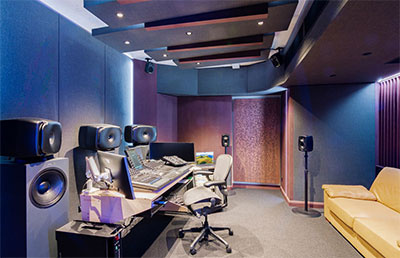Acoustic consulting and media systems engineering company WSDG has completed work on a Dolby Atmos control room for the Centre des Musiques Actuelles (CMA) in Geneva.
CMA includes the École des Musiques Actuelles (EMA), a contemporary music school offering training in pop, rock, jazz, and other modern genres. The facility occupies two floors and includes 45 classrooms, a 300-seat auditorium and a 200-capacity club, as well as recording and production facilities.
 The concept for both the Dolby Atmos control room and the immersive Ansermet Auditorium came from Ladislav Agabekov, sound engineer and technical director at CMA, and made possible through the support of Stefano Saccon, the school’s director, who not only believed in the potential of immersive audio for both education and production, but also championed and carried the project to completion.
The concept for both the Dolby Atmos control room and the immersive Ansermet Auditorium came from Ladislav Agabekov, sound engineer and technical director at CMA, and made possible through the support of Stefano Saccon, the school’s director, who not only believed in the potential of immersive audio for both education and production, but also championed and carried the project to completion.
Eric Henry from ACR Pro was an outstanding partner throughout the process, playing a key role as system integrator and helping to turn the vision into reality with exceptional expertise and dedication.
WSDG served as acoustic consultant for the control room, collaborating with Valentin Cattel from Reynaud Gaillard Architects, who oversaw building integration and installation, and system integrator ACR Pro. The 20m² control room serves as the technical heart of the school’s audio production facilities, enabling immersive recording, mixing, and post work.
‘EMA wanted an Atmos mixing room with a 7.2.4 speaker system,’ explains WSDG Project Engineer, Amin Nehmeh. ‘With Dolby Atmos becoming increasingly prevalent in the industry, the client wanted to ensure they were at the cutting edge, which meant upgrading to the newest standards.’
The control room was designed to interface with EMA’s other facilities, particularly the main auditorium, which is equipped with a d&b audiotechnik Soundscape system featuring 64 loudspeakers for immersive live sound reinforcement projects and performances.
‘We are mainly focused on music production,’ says Agabekov. ‘When we produce a completely object-based live recording in the auditorium, we can immediately reproduce that for the artist in the control room as an immersive experience, and also create binaural content for streaming. It’s very attractive for creative purposes, especially for classical musicians, electronic musicians, and the experimental music clients we frequently host.’
WSDG employed the Niro (Non-cuboid Iterative Room Optimizer) developed by Redi Acoustics to optimise the acoustics of the compact space. The room presented unique challenges due to its size.
‘Funnily enough, the smaller the room, the more thought you need to put into it,’ Nehmeh notes. ‘You have to fight more against the room. Smaller rooms are prone to resonances or eigenmodes at higher frequencies, hence can cause more relevant frequency cancellation issues.’
The acoustic treatment engineered by WSDG includes absorption panels behind the loudspeakers and around the soffit, specially designed ceiling clouds, and a stretch fabric ceiling with built-in insulation toward the rear of the room. A large diffuser occupies a significant portion of the back wall behind the sofa, helping to scatter reflections and enhance spatial clarity. The lower sections up to 60-80cm height feature Helmholtz absorbers for low-frequency control.
The loudspeaker set-up features Genelec 8361 main monitors, W371A subwoofers, and smaller POE-powered surrounds. The system is networked, using Dante and controlled via an Avid S4 controller and Pro Tools.
French company C2A Swiss manufactured the acoustic elements based on specifications from WSDG’s engineering reports. The school’s regular carpenter also made significant contributions to the project, while Eric Henry, Director of Operations at ACR Pro, was also instrumental in the integration process.
‘The results now that I’ve been working in the room are very, very good,’ Agabekov reports. ‘It’s quite an impressive room in terms of its acoustic qualities, and I have two Dolby Atmos live projects that I’m excited to mix in there.’
Agabekov sees a bright future for immersive audio: ‘The Dolby Atmos format for music is not so well implemented in Switzerland as in the US because we don’t have the same calibre of major record labels, and we know that Apple’s Spatial Audio or Dolby Atmos is mainly used by them for the time being. But we expect that it’ll be democratised in the months and years to come.
‘What makes this project particularly special is how seamlessly the Atmos room integrates with our existing performance spaces. The collaborative spirit between all parties involved — from the architects to the WSDG team, the system integrators, and the school itself — created an environment where technical excellence could truly flourish.’
More: www.wsdg.com

